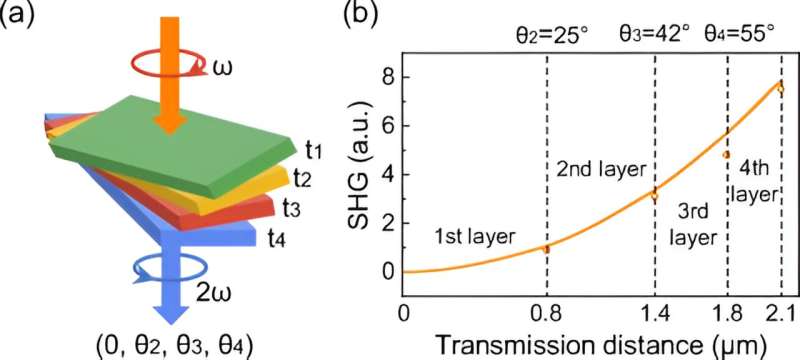This article has been reviewed according to Science X's editorial process and policies. Editors have highlighted the following attributes while ensuring the content's credibility:
fact-checked
peer-reviewed publication
trusted source
proofread
Scientists invent ultrathin optical crystal for next-generation laser tech

A team of Chinese researchers used a novel theory to invent a new type of ultrathin optical crystal with high energy efficiency, laying the foundation for next-generation laser technology.
Prof. Wang Enge from the School of Physics, Peking University, recently told Xinhua that the Twist Boron Nitride (TBN) made by the team, with a micron-level thickness, is the thinnest optical crystal currently known in the world. Compared with traditional crystals of the same thickness, its energy efficiency is raised by 100 to 10,000 times.
Wang, also an academician of the Chinese Academy of Sciences, said this achievement is an original innovation by China in the theory of optical crystals and has created a new field of making optical crystals with two-dimensional thin-film materials of light elements.
The research findings were recently published in the journal Physical Review Letters.
Laser is one of the underlying technologies of the information society. Optical crystals can realize the functions of frequency conversion, parametric amplification, and signal modulation, to name a few, and are the key parts of laser devices.
In the past 60 years, the research and development of optical crystals have been mainly guided by two phase-matching theories proposed by scientists in the United States.
However, due to the limitations of traditional theory models and material systems, the existing crystals have struggled to meet the future requirements for developing laser devices, such as miniaturization, high integration and functionalization. The development of new-generation laser technology needs breakthroughs in optical crystal theory and materials.
Wang Enge and Prof. Liu Kaihui, director of the Institute of Condensed Matter and Material Physics, School of Physics, Peking University, led the team to develop the twist-phase-matching theory, the third phase-matching theory based on the light-element material system.
"The laser generated by optical crystals can be viewed as a marching column of individuals. The twist mechanism can make everyone's direction and pace highly coordinated, greatly improving the energy conversion efficiency of the laser," explained Liu, who is also deputy director of the Interdisciplinary Institute of Light-Element Quantum Materials at the Beijing Huairou National Comprehensive Science Center.
The research has opened up a brand-new design model and material system and realized the original innovation of the whole chain from basic optics theory to material science and technology, he said.
"The TBN crystal's thickness ranges from 1 to 10 microns. The thickness of optical crystals we had known before is mostly at the level of a millimeter or even centimeter," Liu added.
The TBN production technology is now applying for patents in the United States, Britain, Japan, and other countries. The team has made a TBN laser prototype and is developing new-generation laser technology with enterprises.
"Optical crystal is the cornerstone of laser technology development, and the future of laser technology is determined by the design theory and production technology of optical crystals," Wang said.
With ultra-thin size, excellent integration potential, and new functions, the TBN crystal is expected to achieve new application breakthroughs in quantum light sources, photonic chips, artificial intelligence, and other fields in the future, according to Wang.
More information: Hao Hong et al, Twist Phase Matching in Two-Dimensional Materials, Physical Review Letters (2023). DOI: 10.1103/PhysRevLett.131.233801. On arXiv: DOI: 10.48550/arxiv.2305.11511
Journal information: Physical Review Letters , arXiv
Provided by Peking University




















